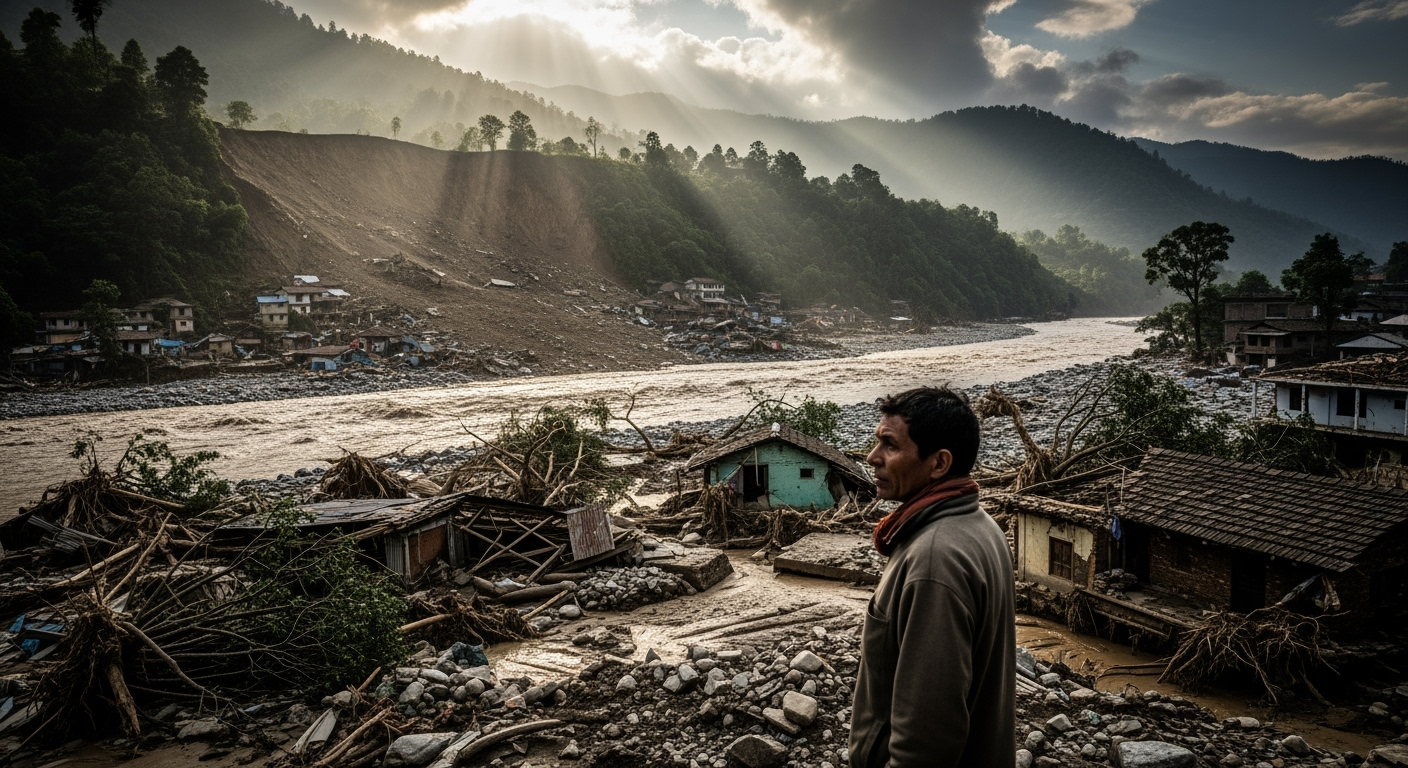Related Articles

Pioneering Quantum Discoveries Earn Trio of U.S.-Based Scientists 2025 Physics Nobel




KATHMANDU – Relentless monsoon rains have unleashed a fresh wave of devastation across Nepal, triggering deadly landslides and flash floods that have claimed at least 47 lives and left several others missing in the past 36 to 48 hours. The ongoing crisis, primarily affecting the eastern Ilam district, has crippled infrastructure, cut off vital transportation routes, and displaced communities, painting a grim picture of the country's annual struggle against the fury of its wet season. As rescue operations intensify, authorities are bracing for continued rainfall, underscoring the urgent need for enhanced disaster preparedness in the Himalayan nation.
The recent deluge, which began late this week, has plunged several regions of Nepal into chaos. As of Sunday, October 5, 2025, at least 47 people have been confirmed dead, with 11 individuals still unaccounted for, according to official reports. The Koshi Province has reported 36 fatalities, while Madhesh Province accounts for three deaths. The Ilam district, bordering India in eastern Nepal, has borne the brunt of the catastrophe, with 27 to 35 lives lost to landslides alone, and five more missing in the district. In one particularly tragic incident, six members of a single family in Ilam were killed when a landslide engulfed their home as they slept.
The widespread impact extends beyond human casualties, severely disrupting daily life and connectivity. Landslides and overflowing rivers have blocked numerous highways, isolating communities and stranding hundreds of passengers. Domestic flights have faced significant disruptions, while the capital, Kathmandu, has seen several rivers flood roads and inundate houses, effectively severing road links to other parts of the country. In southeastern Nepal, the powerful Koshi River has surged to alarming levels, flowing more than double its normal volume, prompting authorities to open all 56 sluice gates of the Koshi Barrage to manage the swollen waters. Rescue efforts are ongoing across the affected regions, with the National Disaster Risk Reduction and Management Authority (NDRRMA) overseeing operations amidst challenging weather conditions. Authorities had issued a four-day travel advisory from October 3-6, urging the public to exercise caution and avoid unnecessary nighttime and long-distance travel due to heightened risks.
This year's crisis echoes the devastating monsoon season of 2024, which proved to be particularly catastrophic for Nepal. That year, heavy rainfall led to 246 fatalities, left 15 people missing, and necessitated the rescue of over 17,000 individuals. The economic fallout was immense, with agricultural losses estimated at NPR 25 billion, and the destruction of approximately 3,000 homes, 100 kilometers of roads, and more than 50 bridges. Infrastructure, particularly in hydropower, irrigation, and river control, sustained losses estimated at NPR 4.35 billion (USD 32 million).
Record-breaking rainfall events underscored the severity of the 2024 monsoon. Between September 27 and 29, 2024, central and eastern Nepal experienced unprecedented downpours, leading to the deaths of 244 people. Some weather stations recorded over 320mm of rainfall, marking the highest levels in 54 years for certain areas. Kathmandu was not spared, with the Bagmati River rising two meters above safe levels, inundating neighborhoods and displacing thousands. Stories of loss, like that of Sita Tamang from Sindhupalchok who lost her home and two family members, or Ramesh Yadav from the Terai region who saw his fields submerged, highlight the profound human cost of these annual disasters.
Nepal's unique geographical features, characterized by towering mountains and a vast river system, inherently make it susceptible to natural disasters, particularly during the monsoon season which typically runs from mid-June to mid-September. However, a confluence of factors, both natural and human-induced, has dramatically intensified the frequency and severity of these events.
Climate change plays a significant role, leading to more unpredictable rainfall patterns, increased intensity of downpours, and accelerated glacial melting, all of which contribute to more severe flooding and landslides. Research indicates that human-made climate change made the heavy rainfall that caused the 2024 floods 70% more likely to occur and approximately 10% more intense. Beyond global climate shifts, local anthropogenic factors exacerbate the risks. Extensive deforestation and poor land management practices reduce soil stability and increase erosion, making slopes more vulnerable to landslides. Rapid and often unplanned urbanization, particularly in metropolitan centers like Kathmandu, has led to construction on floodplains and a concretization of surfaces, disrupting natural drainage systems and increasing runoff. The 2015 Gorkha earthquake also contributed to the problem by destabilizing hillsides and weakening existing infrastructure. Furthermore, unregulated sand mining and encroachment on riverbanks further compound the country's vulnerability.
In response to the perennial threat of natural disasters, the Nepalese government has established frameworks such as the Disaster Risk Reduction and Management Act of 2017, which recognizes floods, landslides, and heavy rainfall as official disaster categories and aims to minimize risks to public life and property. The National Disaster Risk Reduction and Management Authority (NDRRMA) is a central agency in these efforts, issuing advisories and coordinating rescue operations.
Despite these mechanisms, Nepal's disaster management strategy has historically been more reactive than proactive, often struggling with limited resources, poor coordination, and challenges in implementing effective preparedness measures. However, there is growing emphasis on building resilience. In October 2024, the World Bank signed a US$150 million (NPR 20 billion) financing agreement with Nepal, providing contingent financing to bolster the country's capacity to respond to natural hazards and public health emergencies. The United Nations also supports various initiatives, including the development of climate-responsive budgets in all seven provinces, real-time disaster incident reporting systems, and training for local government officials in disaster risk management. Tools like the Flash Flood Prediction Tool exist, capable of predicting flash floods for over 12,000 river segments, highlighting the potential for advanced warning systems if effectively integrated into national strategies.
The current devastating monsoon season serves as a stark reminder of Nepal's ongoing battle against natural calamities. The interplay of its mountainous terrain, the intensifying effects of climate change, and the challenges of rapid, unplanned development means that deadly landslides and flash floods remain an annual threat. While immediate relief and rescue efforts are paramount, the long-term resilience of Nepal's vulnerable communities will depend on a concerted, proactive approach—one that integrates robust early warning systems, sustainable land-use planning, and strengthened disaster preparedness at all levels of governance. The repeated cycles of destruction underscore the critical need for a transformative strategy to mitigate the human and economic toll of these recurring catastrophes.